Deer Of The World
Opportunities In North America — from Blacktails to Brockets
Originally published in the September/October 2024 Issue of Safari Magazine.
This is the first in a series of SAFARI Magazine articles that explores the biology, behavior, geography and hunting opportunities of the amazing animals in the genus Cervidae. Written by a team of experts at Safari Club International Foundation, these articles will enlighten all hunters to the abounding opportunities to hunt Cervidae — from little muntjac to giant moose. This series starts with the huntable North American deer species. — Editors
Deer are one of the most numerous game animal species found in the world. Some estimates put deer numbers around 60 million worldwide.
The Safari Club International Record Book recognizes many deer species and provides a variety of categories. There are 84 distinct listings in the SCI Record Book and 238 different categories of free range, estate and introduced animals.
SAFARI Magazine Features Editor Craig Boddington explores the most prolific North American deer — the white-tailed deer — in his article on page 100. We’ll pick it up with the other Cervidae on the continent. In future issues, we’ll explore species found elsewhere in the world.
BLACK-TAILED DEER
Columbia Black-tailed Deer
No. 1: 184 3/8, free-range, typical, taken in Washington
Where to hunt Columbia blacktails is often debated. However, most experts agree it is common to find them in coastal areas with wet, temperate climates. They can be seen frequenting edge habitats where the timber meets other landforms like meadows, clear-cuts and brushy slopes. They are found from British Columbia down to California. Seasoned hunters utilize a variety of hunting methods with significant success around glassing from vantage points and utilizing the spot and stalk methods.
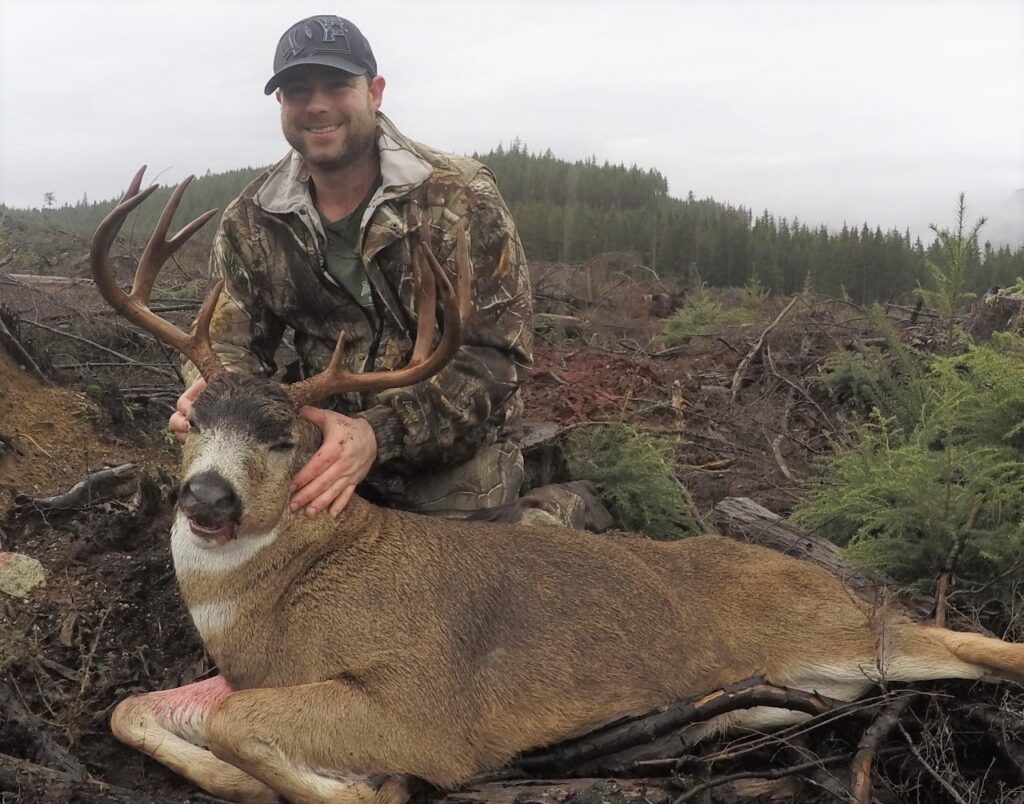
Trophy size can vary. However, the current top SCI Record Book score is 184 3/8 for a typical free-range Columbia deer, which was taken in Washington. Our recommendation is to set your sights on something more reasonable like a 110-inch rack, considered a bronze trophy for rifle and a silver trophy for bow.
The cost for this hunt is in the low-medium range. There are numerous hunting opportunities and professionals. Some blacktail hunters prefer DIY, while others want the probability of bronze, silver or gold trophy and therefore prefer utilizing an outfitter or guide. As trophy expectations increase, so does the cost of the hunt. Some hunters report securing this for $10,000 or less, depending on location and trophy quality.
Sitka Black-tailed Deer
No. 1: 133 2/8, free-range, typical, taken in Alaska
Sitka blacktail hunting is best from the middle of British Columbia up the coast to the Kodiak Archipelagos. This deer may be found as far north as the Kenai Peninsula. However, numbers there are not as plentiful. Like their Columbia cousin, these deer are often associated with coastal areas that are wet and dense with cover.
Sitka black-tailed deer are hunted using a variety of common techniques. Spotting and stalking are common. Some hunters prefer the early August hunt, while others, especially locals, prefer the fall hunt. November hunting is during the rut when both bucks and does will respond to a call resembling the bleat of a fawn. Regardless of the time of year, it is recommended to take a good pair of binoculars. Deer can be seen while glassing from vantage points that provide views of open areas and meadows.
Trophy size can vary but are commonly on the small size compared to mule deer. The current top SCI Record Book score is 133 2/8 for typical free-range Stika deer, which was taken in Alaska. Our recommendation is to set your sights on a smaller trophy of 80 inches or greater, which is the minimum for an SCI bronze trophy with a rifle, while 72 inches is the minimum trophy for bow.
The cost for this hunt is in the low-medium range. There are various hunting opportunities and professionals, many of whom cater to the DIY hunter. As with any DIY hunting, don’t set your expectations too high on bagging a trophy unless you have done a lot of scouting or have local help. Self-guided hunts have been reported to be as low as $1,500 per hunter per week. High-end luxury hunting, complete with gourmet chef and professional outfitting, can be over $10,000 per person and often receives the highest rating from hunters.
Pro tip: Always check with several outfitters or hunt providers to see if there are any other animals you can legally hunt while in the field. Don’t miss a possible opportunity at something you wish you had taken, like a bear, elk, wolf or wolverine.
MULE DEER
Often referred to as muleys or burro, they are the iconic Western state and province deer. However, they also can be found in the central part of the continent. They are considered medium-sized deer and well-built with a thickset body and rather large hooves. The ears are long and wide, resembling those of a mule. The antlers of a mature buck are large and wide. The summer coat is thin and varies in color from tan to rusty red. The rump, belly and inside of the legs are white. The face and throat are whitish, with a black patch on the forehead and a black bar around the chin. The tail is white with a black tip, and sometimes the base of the tail can be brown. The two most common to make our list for hunters to try are the desert and Rocky Mountain mule deer.
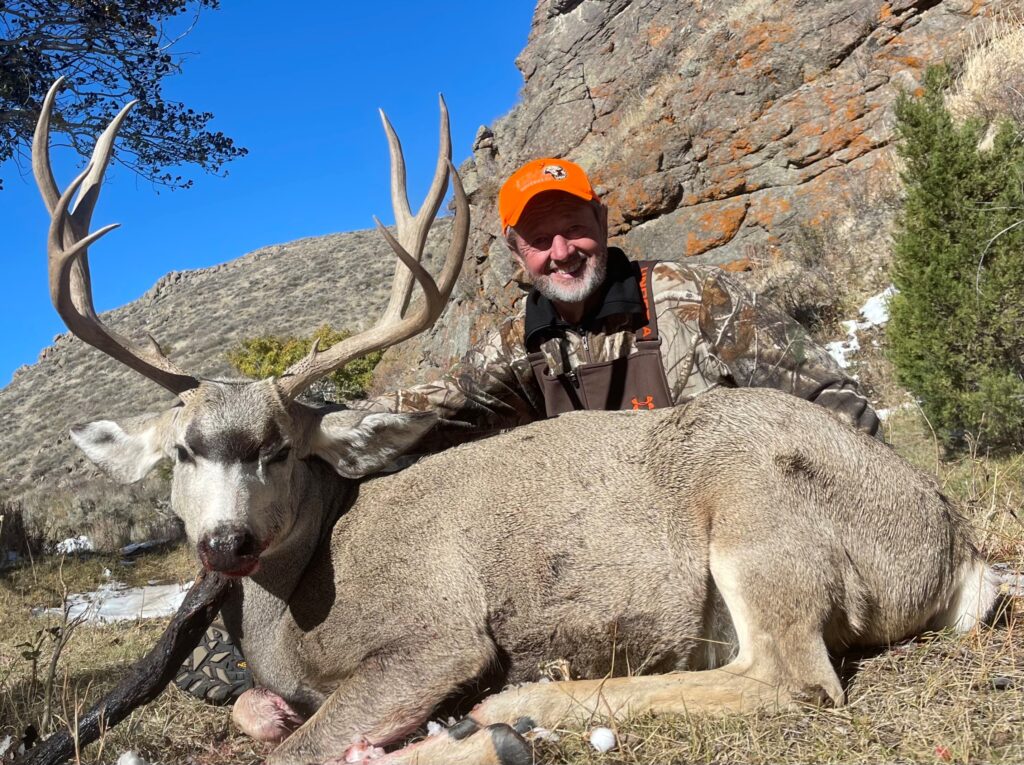
Desert Mule Deer
No. 1: 230 4/8, free-range, typical, taken in Sonora
Desert muleys are often in lower elevations. They are slightly smaller than Rocky Mountain muleys and have antlers that are not as heavy or high as their cousins. They are found in habitats that can be considered extremely harsh conditions with high heat, as well as intense cold, meager forage, scarce water, and lack of vegetative cover. Thus it’s “desert” moniker. The deer calls home the extreme southern portion of California, through Arizona and New Mexico, into central Texas and down into Mexico in portions of northern Sonora to northwestern Coahuila.
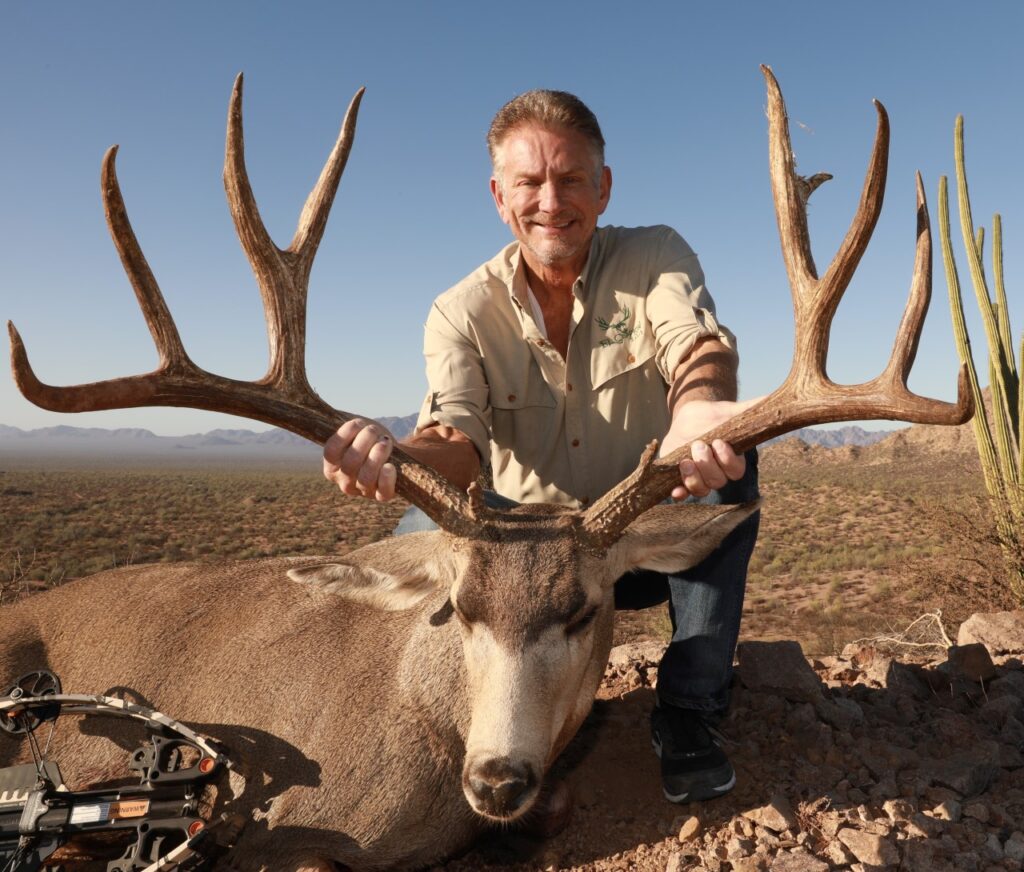
A combination of glassing and stalking is the norm for this deer. Plan on devoting time to glassing through a quality pair of binoculars from vantage points. Mule deer blend into their surroundings. Look for gray movement, shapes and anything that could be a white rump patch. Once you spot a desert muley, be prepared to stalk while paying attention to the direction of the wind. Mule deer have keen eyesight. Utilize cover in an open desert habitat to gain a successful shot setup.
Trophy size varies. The current top SCI Record Book score is 230 4/8 for a typical free-range desert muley. That one was taken in Sonora. Our recommendation is to set your sights on something more reasonable, like a 160-inch rack, which is considered a bronze trophy for rifle and a silver trophy for bow. The minimum SCI score for a trophy desert muley to be placed in the record book is 151 for rifle and 140 for bow in the free-range category.
The cost for this hunt is in the low-mid range, and there are lots of hunting opportunities and professionals. Some of the best hunts are on private ranches, which have limited DIY hunting. If you are looking for a trophy, plan on paying $10,000-$15,000 for a quality buck hunt.
No. 1: 228 5/8, free-range, typical, taken in Utah
Rocky Mountain muleys are found from the north-central part of the southwest, up through the panhandle of Oklahoma, continuing north up through the Canadian provinces and even into the territories.
A fundamental hunting strategy is to check in with your local wildlife agency. Wildlife managers there can tell you where good bucks are routinely harvested. From there, it is a matter of hunter preference. Bucks like deep cover unless the rut is on. The typical strategy is to set up and glass in the mornings and afternoons while planning on staying out until the last shooting light has faded. Big bucks often don’t move around until dusk, so be patient.
Trophy size for Rocky Mountain mule deer varies. The current top SCI Record Book score is 228 5/8 for a free-range, typical, muley deer taken in Utah. Our recommendation is to set your sights on a smaller trophy of 170 inches or greater. The minimum for an SCI bronze trophy with a rifle is 155, while 138 is the minimum trophy for the bow.
The cost for this hunt is in the low to mid-range. These hunts are common, and many professionals are available to meet individual hunter needs. Reports indicate that for a decent hunt with a designated guide, hunters are paying $15,000 plus. Some private land hunts are less; however, we advise you to do your research before booking if you are expecting to bring home a trophy.
Pro tip: Many ranches outside the U.S. offer cull and management bucks of different species, like northern whitetails in Canada or Coues in Mexico, as well as predator population control. Check out the extra available animals before booking.
BROCKET DEER
The brockets are the smallest species of deer found south of the border in Mexico and Central America. Yucatan is a popular destination. They are somewhat similar in appearance to duikers or muntjacs and the SCI Record Book recognizes two huntable species: the red and the gray-brown. There are differences in each of these two deer, so we recommend that you make 100% sure your outfitter knows the differences for each.
Red Brocket
No. 1: 17 2/16, taken in Campeche
Red Brockets are primarily found in the southern part of Mexico and the Yucatan. The key to identifying the red brocket is that it is smaller than its gray cousin and has larger eyes and a lower ridge below its eyes. Their snout is slimmer and elongated. Antler spikes are circular and perfectly straight (not bladed and curved inward like the gray-brown brocket.
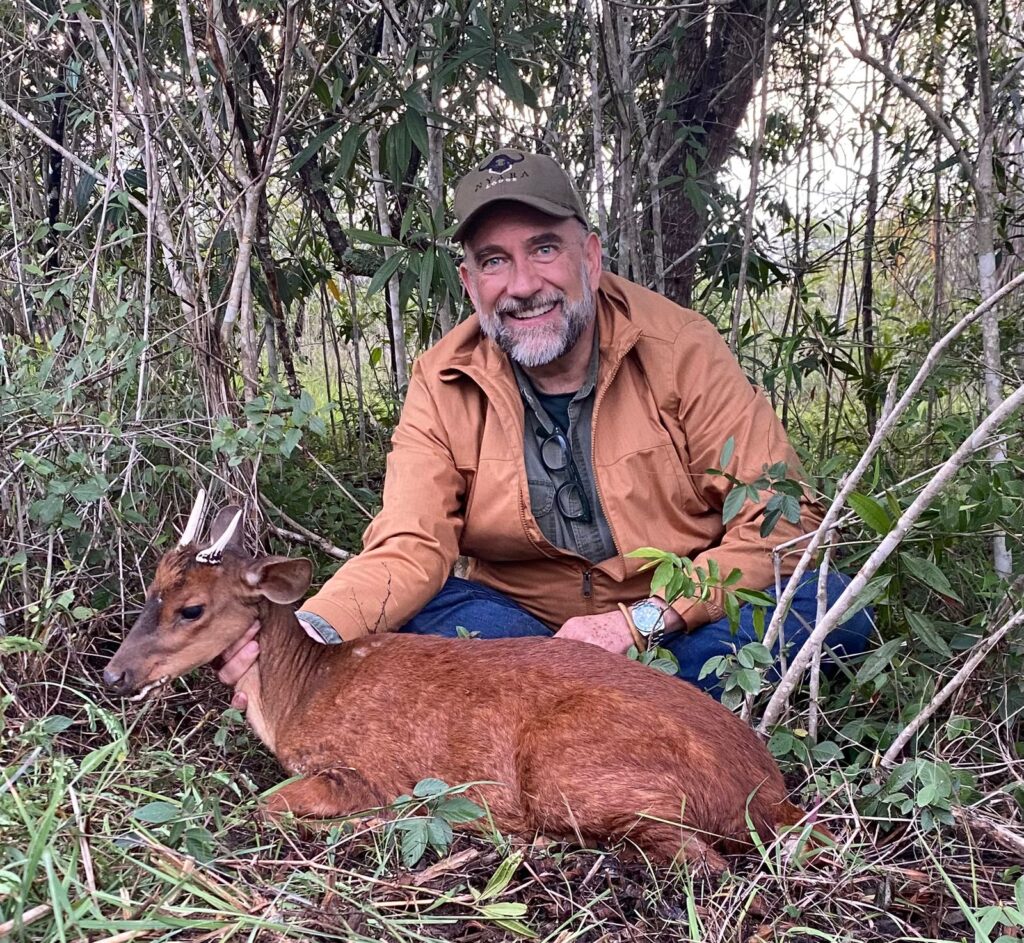
Because the red brockets are jungle dwellers, hunting is often performed from blinds overlooking feed grounds of the amapola tree, which sprouts a pretty flower that the deer devour. The sporting arm of choice for this shy deer is the shotgun because of the dense, close cover and also the elusiveness of the species.
The red brockets are small, but getting one is a trophy regardless of size. Our current top SCI Record Book score is 17 2/16. Due to size, this deer’s antlers are measured in 16ths of an inch. It was taken in the state of Campeche in Mexico. Our recommendation is to set your sights on a gold standard buck of 8 4/16 or greater. The minimum for an SCI bronze trophy with a rifle is 7, while no minimum trophy for a bow has been recorded. It will be hard to pass up a buck as they are so elusive; however, we recommend not shooting a deer with antlers under 2 inches to give it a chance to grow and contribute its genetics to this species.
The cost for this hunt is in the low range. Hunters report securing a red hunt for under $10,000, which can come with lodging and meals. Spanish is the primary language in red brocket habitat so going with a professional outfitter is critical to ensure a hunter is set up in the proper hunting spot.
Gray-brown Brocket
No. 1: 24 11/16, taken in Campeche
Gray-brown brockets are also found in the southern part of Mexico and the Yucatan but are much more numerous. It has a larger head than its red cousin, is lighter-colored and more elegantly shaped. The overall color is grayish brown (or brownish gray, and sometimes even reddish), with the head, back of the neck, hindquarters, top of the tail and lower legs a burnished bronze. The ears are larger with antler spikes that are bladed and curved, which is a crucial feature, and not circular and perfectly straight like with red brocket.
Although a forested animal, it is not typically found in the heart of the jungle like the reds but prefers scrub and bush-type covers. The grays are more diurnal and are active at dusk and dawn. Rifles, shotguns and even bows are successful hunting sporting arms.
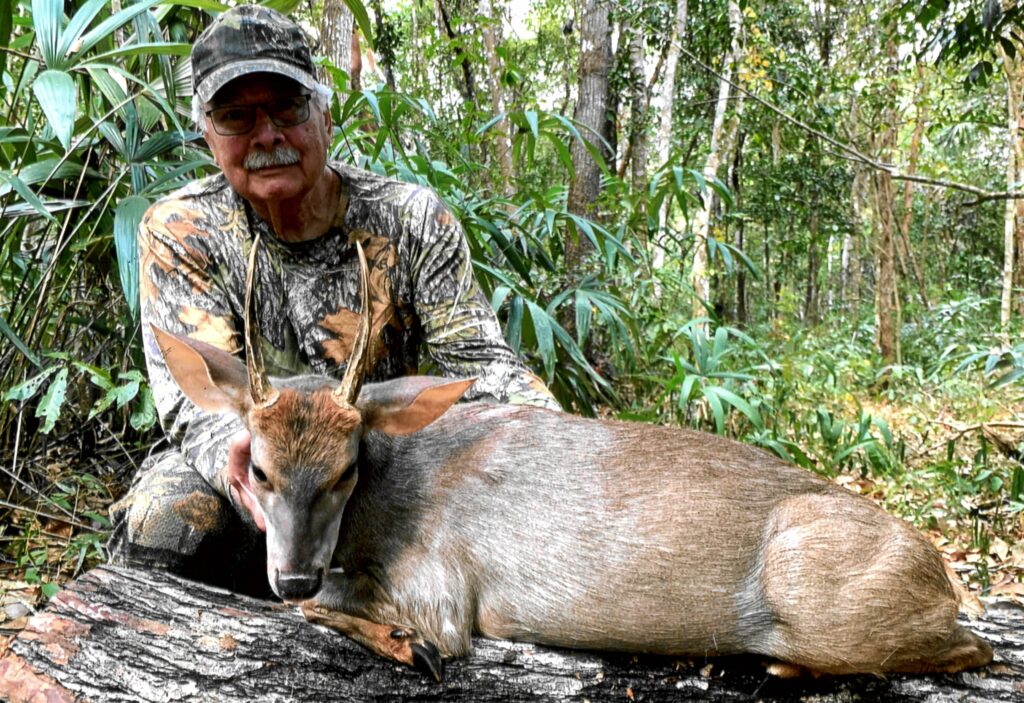
These brockets are small but not as small as the reds. Our current top SCI Record Book score is 24 11/16, which was taken in Campeche, Mexico. Our recommendation is to set your sights on a silver standard buck of 12 inches or greater, but at least hold out for a deer with 4 inches of length for each antler. The minimum for an SCI bronze trophy with a rifle is 10, while no minimum trophy for a bow has been recorded.
The cost for this hunt is in the low range. Hunters report securing a hunt for under $7,500, which can come with lodging and meals. Like a red brocket hunt, Spanish is the primary language, so we recommend going with a professional outfitter to ensure a hunter is set up for success.
Pro tip: You don’t need to take your shotgun if the outfitter is willing to let you use his. But be absolutely sure to take bug spray for the ants, chiggers, mosquitoes and ticks.
SCIF President Brian Welker, Record Book Manager Aaron Smith, Conservation Program Manager Dan Brooks, Record Book Coordinator Duane Aubuchon and Hunter Information Services Liaison Barbara Crown co-authored this article.

